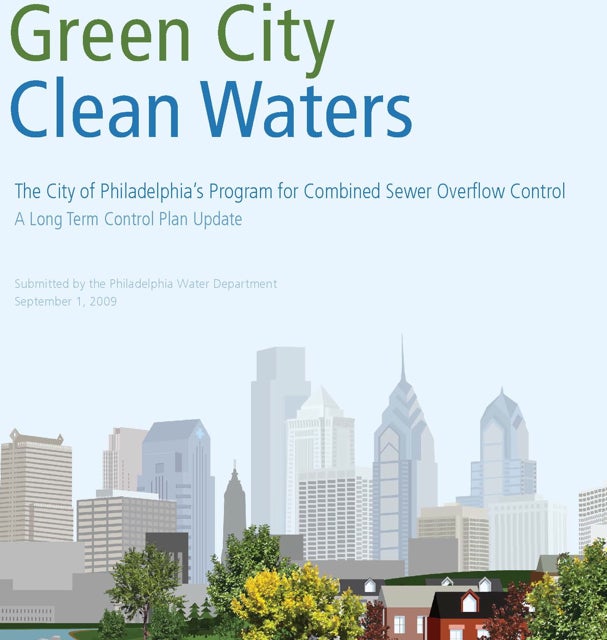A new course: From tunnels to trees

Oct. 1
Previous PlanPhilly coverage: Stormwater infrastructure; How we manage our stormwater
By Arrus Farmer
For PlanPhilly
Howard Neukrug, the Philadelphia Water Department’s Director of the Office of Watersheds, gave PlanPhilly a first look at PWD’s new Green Cities – Clean Water plan that was submitted to the U.S. Environmental Protection Agency in September. The water department is using some innovative and holistic approaches in an attempt to make Philadelphia America’s Greenest City.
When most folks think about stormwater, images of streams racing down curbsides during heavy downpours come to mind. Those roadside rapids are likely indicators that stormwater management isn’t being done right. The Philadelphia Water Department is switching up its strategy to address these issues, and looking to nature for a green solution.
Traditionally, an urban stormwater management system would collect rain and snow runoff, often combine it with household waste, treat it, and then discharge it into the waterways of the region in safe volumes and at acceptable federal water quality levels.
During heavy rain events though, traditional municipal systems can be easily overwhelmed. Waste water treatment facilities get overloaded, sewers overflow and that water is routed directly to the Schuylkill River, the Delaware, and the regions valuable creeks and streams, making them unsafe for humans and potentially deadly for fish and wildlife.
For the past 100 years, the solution usually has been a pricey intervention: build bigger – wider pipes and tunnels and more wastewater treatment plants.
In 1999, the Office of Watersheds (OOW) was formed at the Philadelphia Water Department in order to develop programs and policy to better handle the city’s wastewater and protect our watersheds. Since then OOW has been establishing some nationally recognized best practices and getting positive recognition from clean water groups and the U.S. Environmental Protection Agency. But a recent piece of planning work is pushing the regulatory envelope and the Federal Clean Water Act by the ways it redefines stormwater management.
Director Howard Neukrug says that his department is “changing the way they look at rainwater and how it is handled. We value water and we’re changing the traditional way stormwater is managed … between homes, businesses and the environment. We are taking that (old, grey infrastructure) barrier down, and are stopping the water from ever hitting the system.
“We now look at our city’s streets with an eye that seeks opportunities to peel back the existing concrete and asphalt and replace it with a new landscape, rich with vegetation that welcomes the rain – storing, draining and cleaning it.”
Neukrug is talking about “Green Infrastructure.” Green as opposed to grey infrastructure is a stormwater management tool that focuses on the use of vegetation to collect and treat stormwater as opposed to using man made components such as drains, pipes and treatment plants. It essentially allows Mother Nature to do her job naturally and brings a little green benefit to the city at the same time.
Philadelphia, like most other American cities, is practically covered by a layer of asphalt and concrete – nearly impossible for rainwater to penetrate. Stormwater runs directly into the traditional grey system we have today.
Green Cities – Clean Water makes the case that green infrastructure is about more than just stormwater. The analysis uses a triple bottom line method analyzing not only the economic costs and benefits but also the social and ecological ones as well. Experts detail numerous ancillary benefits to green infrastructure over the traditional grey: increased property values, reduced greenhouse gas emissions, and numerous health benefits associated with breathing cleaner air and having more shade in the city.
The water department won’t be going it alone, either. A coalition of city agencies including Parks & Recreation, Streets, the Office of Sustainability and the School District are coming together to help make Mayor Michael Nutter’s call for Philadelphia to become America’s greenest city a reality.
To do so, the water department is using an innovative metric: the “Greened Acre.” That is an area of land that uses green infrastructure to capture a minimum of one inch of rainwater during every storm event. Every time it rains less than an inch, that acre would not route any wastewater to the combined sewer system, thus taking the burden off the traditional system and preventing up to 90% of the pollutants associated with stormwater runoff from entering our watersheds.
The Plan offers eight program areas where 4,000 greened acres could be created:
• Green Streets
• Green Alleys, Driveways, and Walkways
• Green Schools
• Green Public Facilities
• Green Parking
• Green Open Space
• Green Industry, Business, Commerce and Institutions
• and Green Homes
Over the 20 years of future incremental implementation, the water department expects to invest roughly $1.6 billion to create the program. In comparison to tunnels and pipes, the green method has a host of additional benefits, which according to the Green Cities – Clean Water Report will result in $2 in benefits for every $1 PWD invests.
Recent updates to stormwater fees are providing the primary source of funds for the plan’s implementation and simultaneously motivating residents and business owners to initiate green infrastructure projects on their own. Neukrug says the new fee structure was created to reflect the “true cost of service.” It used to be that businesses and residents were charged by their metered water use: so more water use produced a bigger bill, but large impervious properties added more stormwater to the system, and were not in the billing equation.
So, under the previous system, many commercial and industrial uses weren’t being charged enough – for example traditional parking lots create a tremendous amount of stormwater pollution but have small or no water bills at all.
The new stormwater fees assess charges based on how impervious a property is and provide incentives for commercial uses that implement measures to reduce the stormwater impact. “The goal here is to actually lose customers” says Neukrug. “We want to keep our utility customers and keep them satisfied, but today, with this new initiative and these incentives – we are trying to motivate people to process their own stormwater on-site through natural vegetation.” In addition to rate reductions, the water department offers streamlined processing to developers using innovative water management solutions on new developments and requires those over 15,000 square feet to follow their Greened Acre mandate – handling the first inch of rainwater during storm events. These incentives have placed Philadelphia and the water department’s efforts on the EPA’s list of national best management practices for municipalities to follow.
With the submission of the full 700-page document to the EPA on September 1, the water department is navigating uncharted territory. It is their hope that the EPA will approve this innovative approach to water management and allow it to satisfy the Federal Clean Water Act requirements for the city.
Generally, Clean Water Act compliance would be verified and controlled by the Pennsylvania Department of Environmental Protection. Due to the scale and amount of investment involved here though, the federal EPA will be overseeing the plan’s compliance evaluation.
Jon Capacasa, the EPA’s Mid-Atlantic Director of Water Protection, says that they will ensure that the plan complies with the agency’s Combined Sewer Overflow Control policy.
Neukrug points out that nothing like this has been done before at a citywide scale. New York, Portland, Chicago, and Seattle all have similar programs but at project levels, “they are offering side salads, what we have in mind is a seven-course meal.”
The EPA has promoted Green Infrastructure methods for handling wastewater for the past decade – providing guidance for municipalities and utilities for implementation, funding, and promotion. The trouble, however, as Neukrug puts it, is that although “EPA’s mission is widespread, when the EPA talks to the water department, it is very difficult for them to consider the wider spectrum of issues like heat island effect, greenhouse gas emissions and public health concerns.”
Among other checks, the EPA will ensure that acceptable levels and qualities of overflow are being routed to rivers and streams, that the plan is affordable both to the city and utility customers, and that it contains measureable outcomes. Capacasa stresses the importance of “measurable milestones for a plan with a 20-year time horizon and $1.6 billion in investment.”
The Office of Watersheds is making an argument with this initiative that appeals to common sense. Instead of investing billions underground in tunnels and drain pipes, spend the money to install natural infrastructure that gets the job done and simultaneously makes our communities more attractive, more economically viable and healthier places to live, work and play.
As simple as it seems, Neukrug illustrates a thoughtful and pensive strategy moving forward: “We recognize the potential power of this program, as well as its, well, unorthodoxy. We are moving slowly with the EPA to ensure that, all of our bases are covered and that any avoidable mistakes are identified. There is simply too much at risk here.”
The regulatory agencies will be careful in reviewing the water department’s plan as well. Capacasa expects at least 60 days of review time and careful coordination between the state and federal environmental agencies before comments and possible approval can be offered.
Although specific comment won’t be available for a few months, Capacasa calls PWD’s work encouraging. “The EPA has promoted these types of long-term green infrastructure projects to manage stormwater for a decade … including smaller scale demonstration projects with the water department … it is encouraging to see them planned at such a wide scale in Philadelphia.”
At the local and state levels, the plan is drawing partners from all corners. Fourteen local agencies are listed among the groups contributing to the efforts thus far and with that Green Cities – Clean Water invokes exactly the comprehensive scale needed to make Philadelphia America’s greenest city.
Check out the report summary at: http://www.phillywatersheds.org/ltcpu/
Arrus Farmer was most recently a Robert Bosch Fellow based in Berlin, Germany working in the planning and administration of large scale public-private developments. He holds both a Masters of City Planning and a Masters of Government Administration from the University of Pennsylvania which were completed earlier this year. Farmer has worked with Praxis on a number of civic engagement projects including the Civic Vision for the Central Delaware Riverfront.
Contact the reporter at arrus.farmer@alumni.upenn.edu
WHYY is your source for fact-based, in-depth journalism and information. As a nonprofit organization, we rely on financial support from readers like you. Please give today.




